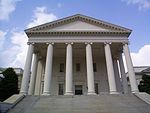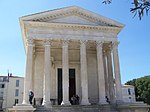Просмотр содержимого документа
«Political legacy in Roman Empire»
Roman Empire
Political legacy[edit] Main article: Legacy of the Roman Empire


The Virginia State Capitol (left), built in the late 1700s, was modelled after the Maison Carrée (right), in Nîmes, France, a Gallo-Roman temple built around 16 BC under Augustus.
Several states claimed to be the Roman Empire's successors after the fall of the Western Roman Empire. The Holy Roman Empire, an attempt to resurrect the Empire in the West, was established in 800 when Pope Leo III crowned Frankish King Charlemagne as Roman emperor on Christmas Day, though the empire and the imperial office did not become formalized for some decades. It maintained its title until its dissolution in 1806, with much of the Empire reorganized into the Confederation of the Rhine by Napoleon Bonaparte: crowned as Emperor of the French by Pope Pius VII. Still, his house would also lose this title after Napoleon abdicating and renouncing not only his own rights to the French throne and all of his titles, but also those of his descendants on 6 April 1814.
After the fall of Constantinople, the Russian Tsardom, as inheritor of the Byzantine Empire's Orthodox Christian tradition, counted itself the Third Rome (Constantinople having been the second). These concepts are known as translatio imperii.[666] After the succession of the Russian Tsardom by the Russian Empire, ruled by the House of Romanov, this ended in the Russian Revolution of 1917 when Bolshevik revolutionaries toppled the monarchy.[667]
After the sale of the Imperial Title by the last Eastern Roman titular, Andreas Palailogos, to Ferdinand II of Aragon and Isabella I of Castile, and the Dynastic Union between these two that proclaimed the Kingdom of Spain, it became a direct successor to the Roman Empire until today, after three restorations of the Spanish Crown.
When the Ottomans, who based their state on the Byzantine model, took Constantinople in 1453, Mehmed II established his capital there and claimed to sit on the throne of the Roman Empire.[668] He even launched an invasion of Otranto, located in Southern Italy, with the purpose of re-uniting the Empire, which was aborted by his death. Mehmed II also invited European artists to his capital, including Gentile Bellini.[669][670]
In the medieval West, "Roman" came to mean the church and the Pope of Rome. The Greek form Romaioi remained attached to the Greek-speaking Christian population of the Eastern Roman Empire and is still used by Greeks in addition to their common appellation.[671]
The Roman Empire's territorial legacy of controlling the Italian peninsula would influence Italian nationalism and the unification of Italy (Risorgimento) in 1861.[672] Further Roman imperialism was claimed by fascist ideology, particularly by the Italian Empire and Nazi Germany.
In the United States, the founders were educated in the classical tradition,[673] and used classical models for landmarks and buildings in Washington, D.C., to avoid the feudal and religious connotations of European architecture such as castles and cathedrals.[674][675][676][677][678][679][680] In forming their theory of the mixed constitution, the founders looked to Athenian democracy and Roman republicanism for models, but regarded the Roman emperor as a figure of tyranny.[681][682]



















